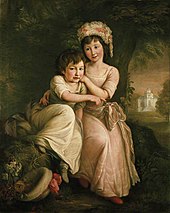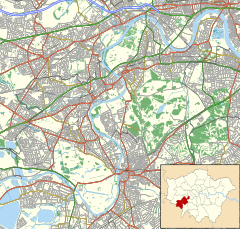King's Observatory
| The King's Observatory | |
|---|---|
| Kew Observatory | |
 The King's Observatory in winter | |
| Location | Old Deer Park |
| Nearest city | Richmond, London |
| Coordinates | 51°28′08″N0°18′53″W/ 51.4689°N 0.3147°W |
| Built | 1769 |
| Built for | George III of the United Kingdom |
| Original use | Astronomical and terrestrial magnetic observatory |
| Current use | Private dwelling |
| Architect | Sir William Chambers |
| Owner | Crown Estate |
| Website | www |
Listed Building– Grade I | |
| Official name | Kew Observatory |
| Designated | 10 January 1950 |
| Reference no. | 1357729 |
The King's Observatory(called for many years theKew Observatory)[1]is a Grade Ilisted building[2]inRichmond, London.Now a private dwelling, it formerly housed anastronomicalandterrestrial magneticobservatory[3]founded byKing George III.The architect wasSir William Chambers;his design of the King's Observatory influenced the architecture of two Irish observatories –Armagh ObservatoryandDunsink ObservatorynearDublin.[4]
Location
[edit]Theobservatoryand its grounds are located within the grounds of theRoyal Mid-Surrey Golf Club,which is part of theOld Deer Parkof the formerRichmond PalaceinRichmond,historically inSurreyand now in theLondon Borough of Richmond upon Thames.The former royal manor ofKewlies to the immediate north. The observatory grounds overlie to the south the site of the formerSheen Priory,theCarthusianmonastery established byKing Henry Vin 1414.[5]The observatory is not publicly accessible, and obscuring woodlands mean that it cannot be viewed from outside the golf course, which is not open to the general public.
People
[edit]Directors (superintendents) of the observatory includedStephen Demainbray,Francis Ronalds,John Welsh,Balfour Stewart,Francis John Welsh Whipple,Charles Chree,andGeorge Clarke Simpson.
History
[edit]The observatory was completed in 1769,[6]in time for King George III's observation of thetransit of Venusthat occurred on 3 June in that year. It was located close toRichmond Lodge,[7]the country residence of the royal family between 1764 and 1771.[8]
In 1842, the by then empty building was taken on by theBritish Association for the Advancement of Scienceand became widely known as the Kew Observatory.[9]Francis Ronaldswas the inaugural Honorary Director for the next decade and founded the observatory's enduring reputation.
Responsibility for the facility was transferred to theRoyal Societyin 1871. TheNational Physical Laboratorywas established there in 1900 and from 1910 it housed theMeteorological Office.The Met Office closed the observatory in 1980. The geomagnetic instruments had already been relocated toEskdalemuir ObservatoryinDumfries and Galloway,Scotland in 1908 after the advent of electrification in London led to interference with their operations.[10]
Scientific achievements
[edit]Observing the transit of Venus on 3 June 1769
[edit]
A contemporary report byStephen Demainbray,the superintendent of the observatory, says: "His Majesty the King who made his observation with aShortsreflecting telescope, magnifying Diameters 170 Times, was the first to view the Penumbra of Venus touching the Edge of the Sun's Disk. The exact mean time (according to civil Reckoning) was attended to by Stephen Demainbray, appointed to take exact time by Shelton's Regulator, previously regulated by several astronomical observations. "[11]
Self-registering instruments
[edit]Francis Ronaldsinvented many meteorological, magnetic and electrical instruments at Kew, which saw long-term use around the world. These included the first successfulcamerasin 1845 to record the variations of parameters such asatmospheric pressure,temperature,humidity,atmospheric electricityandgeomagnetismthrough the day and night.[12]His photo-barographwas used byRobert Fitzroyfrom 1862 in making the UK's first officialweather forecastsat theMeteorological Office.The network of observing stations set-up in 1867 by the Met Office to assist in understanding the weather was equipped with his cameras – some of these remained in use at Kew until the observatory's closure in 1980.[13]
Atmospheric electricity observations
[edit]Ronalds also established a sophisticatedatmospheric electricityobserving system at Kew with a long copper rod protruding through the dome of the observatory and a suite of novelelectrometersandelectrographsto manually record the data. He supplied this equipment to facilities in England, Spain, France, Italy, India (ColabaandTrivandrum) and theArcticwith the goal of delineating atmospheric electricity on a global scale.[14]At Kew, two-hourly data was recorded in the Reports of the British Association between 1844 and 1847.
An entirely new system, providing continuous automatic recording, was installed byLord Kelvinpersonally in the early 1860s. This device, based on Kelvin's water dropper potential equaliser with photographic recording,[15]was known as the Kew electrograph. It provided the backbone of a long and almost continuous series of potential gradient measurements which finished in 1980. A secondary system of measurement, operating on different principles, was designed and implemented by the Nobel laureateCTR Wilson,from which records begin in 1906 until the closure of the Observatory.[16]These measurements, which complement those of the Kelvin electrograph, were made on fine days at 1500 GMT. Beyond their applications in atmospheric electricity, the electrograph and Wilson apparatus have been shown to be useful for reconstructing past air pollution changes.[17]
Testing timepiece movements
[edit]In the early 1850s, the facility began performing a role in assessing and ratingbarometers,thermometers,chronometers,watches,sextantsand other scientific instruments for accuracy; this duty was transferred to theNational Physical Laboratoryin 1910. An instrument which passed the tests was awarded a "Kew Certificate", a hallmark of excellence.[18]
Asmarine navigationadopted the use of mechanical timepieces, their accuracy became more important. The need for precision resulted in the development of a testing regime involving various astronomical observatories. In Europe,Neuchâtel Observatory,Geneva Observatory,Besançon Astronomical Observatoryand Kew were examples of prominent observatories that tested timepiece movements for accuracy. The testing process lasted for many days, typically 45. Each movement was tested in five positions and two temperatures, in ten series of four or five days each. The tolerances for error were much finer than any other standard, including the modernCOSCstandard. Movements that passed the stringent tests were issued a certification from the observatory called a Bulletin de Marche, signed by the directeur of the observatory. The Bulletin de Marche stated the testing criteria and the actual performance of the movement. A movement with a Bulletin de Marche from an observatory became known as anObservatory Chronometer,and was issued a chronometer reference number by the observatory.
The role of the observatories in assessing the accuracy of mechanical timepieces was instrumental in driving the mechanical watchmaking industry toward higher and higher levels of accuracy. As a result, modern high quality mechanical watch movements have an extremely high degree of accuracy. However, no mechanical movement could ultimately compare to the accuracy of aquartz movement.Accordingly, such chronometer certification ceased in the late 1960s and early 1970s with the advent of the quartz watch movement.
Later use
[edit]In 1981 the facility was returned to theCrown Estate Commissionersand reverted to its original name, "King’s Observatory". In 1985 the observatory was refurbished and transformed into commercial offices; new brick buildings were added. From 1986 to 2011 it was used by Autoglass (nowBelron) as their UK head office.[19]Since 1989 the lease has been held by Robbie Brothers of Kew Holdings Limited.[19]
In 1999, landscape architect Kim Wilkie was commissioned to prepare a master plan linking the observatory's Grade I landscape toKew Gardens,Syon ParkandRichmond.These proposals were accepted by Kew Holdings Limited. In 2014Richmond upon Thames London Borough Councilgranted planning permission for the observatory to be used as a private single family dwelling. All auxiliary buildings have been demolished.
The Observatory in art
[edit]
TheAshmolean Museum of Art and ArchaeologyinOxfordhas a portrait,Peter Rigaud and Mary Anne Rigaud,by the 18th-century painterJohn Francis Rigaud.His portrait of his nephew and niece, exhibited at theRoyal Academyin 1778, showsStephen Peter Rigaud(1774–1839) (who became a mathematical historian and astronomer, andSavilian Chair of GeometryandSavilian Professor of Astronomyat theUniversity of Oxford) and his elder sister. The picture, painted when they were aged four and seven, shows them in a park landscape with the observatory (where their father was observer) in the background.[20]Although described here asRichmond Park,topographicalconsiderations make it more likely that the park portrayed is Old Deer Park, where the observatory is situated.
See also
[edit]Notes and references
[edit]- ^Scott, Robert Henry(1885)."The History of the Kew Observatory" inProceedings of the Royal Society of London, Vol. XXXIX.Royal Society.pp. 37–86.
- ^Historic England(10 January 1950)."Kew Observatory (1357729)".National Heritage List for England.Retrieved21 February2021.
- ^Hunt, Andrew (21 January 2007)."Where a king watched a transit of Venus".Cities of Science.Archived fromthe originalon 28 March 2008.Retrieved8 March2014.
- ^"The King's Observatory at Richmond".History.Armagh Observatory.22 February 2010. Archived fromthe originalon 4 March 2016.Retrieved21 March2015.
- ^Diagram on p. 51 ofCloake, John(1990).Richmond's Great Monastery, The Charterhouse of Jesus of Bethlehem of Shene.London:Richmond Local History Society.ISBN0-9508198-6-7.
- ^Cherry, BridgetandPevsner, Nikolaus(1983).The Buildings of England – London 2: South.London:Penguin Books.p. 520.ISBN0-14-0710-47-7.
{{cite book}}:CS1 maint: multiple names: authors list (link) - ^Watkin, David.The Architect King: George III and the Culture of the Enlightenment.Royal Collection,2004. p.108
- ^Black, Jeremy.George III: America's Last King.Yale University Press,2008. p.175
- ^MacDonald, Lee (2018).Kew Observatory & the evolution of Victorian science, 1840–1910.Pittsburgh, PA.ISBN9780822983491.OCLC1038801663.
{{cite book}}:CS1 maint: location missing publisher (link) - ^"A Scientific Workshop Threatened by Applied Science: Kew Observatory to Be Removed Owing To The Disturbance Caused by Electric Traction".The Illustrated London News.8 August 1903.
- ^Manuscript ofStephen Demainbray's notebook of the Transit of Venus 1769, "The Observatory: A Monthly Review of Astronomy" (1882) called 'Dr Demainbray and the King's Observatory at Kew'. The manuscript is now held atKing's College Londonand is quoted in"The King's Observatory at Kew & The Transit of Venus 1769".Arcadian Times.Retrieved4 August2013.
- ^Ronalds, B. F. (2016).Sir Francis Ronalds: Father of the Electric Telegraph.London:Imperial College Press.ISBN978-1-78326-917-4.
- ^Ronalds, B. F. (2016)."The Beginnings of Continuous Scientific Recording using Photography: Sir Francis Ronalds' Contribution".European Society for the History of Photography.Retrieved2 June2016.
- ^Ronalds, B. F. (June 2016). "Sir Francis Ronalds and the Early Years of the Kew Observatory".Weather.71(6): 131–134.Bibcode:2016Wthr...71..131R.doi:10.1002/wea.2739.S2CID123788388.
- ^Aplin, K. L.; Harrison, R. G. (3 September 2013)."Lord Kelvin's atmospheric electricity measurements".History of Geo- and Space Sciences.4(2): 83–95.arXiv:1305.5347.Bibcode:2013HGSS....4...83A.doi:10.5194/hgss-4-83-2013.ISSN2190-5029.S2CID9783512.
- ^Harrison, R. G.; Ingram, W. J. (July 2005). "Air–earth current measurements at Kew, London, 1909–1979".Atmospheric Research.76(1–4): 49–64.Bibcode:2005AtmRe..76...49H.doi:10.1016/j.atmosres.2004.11.022.ISSN0169-8095.
- ^Harrison, R. G.; Aplin, K. L. (September 2002). "Mid-nineteenth century smoke concentrations near London".Atmospheric Environment.36(25): 4037–4043.Bibcode:2002AtmEn..36.4037H.doi:10.1016/s1352-2310(02)00334-5.ISSN1352-2310.
- ^Macdonald, Lee T. (26 November 2018)."University physicists and the origins of the National Physical Laboratory, 1830–1900".History of Science.59(1): 73–92.doi:10.1177/0073275318811445.PMID30474405.S2CID53792127.
- ^abBrothers, Robbie."Home page".The King's Observatory.Retrieved31 October2018.
- ^"John Francis Rigaud (1742–1810): Stephen Peter Rigaud and Mary Anne Rigaud".Browse the Paintings Collection.Ashmolean Museum of Art and Archaeology.Retrieved13 July2013.
Further reading
[edit]- Harris, John (1970).Sir William Chambers: Knight of the Polar Star.London: Zwemmer.ISBN9780302020760.
- MacDonald, Lee T.Kew Observatory and the Evolution of Victorian Science, 1840–1910.Science and Culture in the Nineteenth Century series.University of Pittsburgh Press,2018.ISBN978-0-8229-4526-0.
- McLaughlin, Stewart (1992)."The Early History of Kew Observatory"(PDF).Richmond History: Journal of the Richmond Local History Society.13:48–49.ISSN0263-0958.Retrieved20 February2021.
- Mayes, Julian (2004). "The History of Kew Observatory".Richmond History: Journal of the Richmond Local History Society.25:44–57.ISSN0263-0958.
External links
[edit]- History of the Observatory and Old Deer Park; historical report by John Cloake
- The Observatory and Obelisks, Kew (Old Deer Park)
- Google Books on the "Kew Observatory"
- Google Scholar on the "Kew Observatory"
- Richmond Local History Society
- The National Archives (UK): Records of the Kew Observatory
- Janus: Kew Observatory papers – at the Royal Greenwich Observatory Archives
- 1769 establishments in England
- 1980 disestablishments in England
- Astronomical observatories in England
- Defunct astronomical observatories
- Buildings and structures completed in 1769
- Buildings and structures in the London Borough of Richmond upon Thames
- Geophysical observatories
- George III
- Grade I listed buildings in the London Borough of Richmond upon Thames
- History of the London Borough of Richmond upon Thames
- Met Office
- National Physical Laboratory (United Kingdom)
- Old Deer Park
- Science and technology in London
- William Thomson, 1st Baron Kelvin



